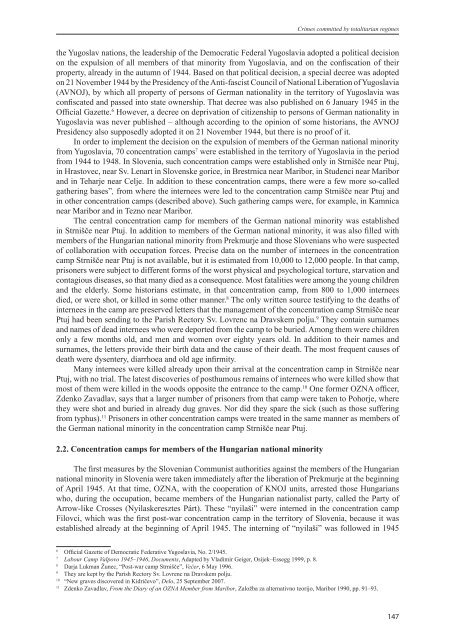crimes committed by totalitarian regimes - Ministrstvo za pravosodje
crimes committed by totalitarian regimes - Ministrstvo za pravosodje
crimes committed by totalitarian regimes - Ministrstvo za pravosodje
You also want an ePaper? Increase the reach of your titles
YUMPU automatically turns print PDFs into web optimized ePapers that Google loves.
Crimes <strong>committed</strong> <strong>by</strong> <strong>totalitarian</strong> <strong>regimes</strong><br />
the Yugoslav nations, the leadership of the Democratic Federal Yugoslavia adopted a political decision<br />
on the expulsion of all members of that minority from Yugoslavia, and on the confiscation of their<br />
property, already in the autumn of 1944. Based on that political decision, a special decree was adopted<br />
on 21 November 1944 <strong>by</strong> the Presidency of the Anti-fascist Council of National Liberation of Yugoslavia<br />
(AVNOJ), <strong>by</strong> which all property of persons of German nationality in the territory of Yugoslavia was<br />
confiscated and passed into state ownership. That decree was also published on 6 January 1945 in the<br />
Official Gazette. 6 However, a decree on deprivation of citizenship to persons of German nationality in<br />
Yugoslavia was never published – although according to the opinion of some historians, the AVNOJ<br />
Presidency also supposedly adopted it on 21 November 1944, but there is no proof of it.<br />
In order to implement the decision on the expulsion of members of the German national minority<br />
from Yugoslavia, 70 concentration camps 7 were established in the territory of Yugoslavia in the period<br />
from 1944 to 1948. In Slovenia, such concentration camps were established only in Strnišče near Ptuj,<br />
in Hrastovec, near Sv. Lenart in Slovenske gorice, in Brestrnica near Maribor, in Studenci near Maribor<br />
and in Teharje near Celje. In addition to these concentration camps, there were a few more so-called<br />
gathering bases”, from where the internees were led to the concentration camp Strnišče near Ptuj and<br />
in other concentration camps (described above). Such gathering camps were, for example, in Kamnica<br />
near Maribor and in Tezno near Maribor.<br />
The central concentration camp for members of the German national minority was established<br />
in Strnišče near Ptuj. In addition to members of the German national minority, it was also filled with<br />
members of the Hungarian national minority from Prekmurje and those Slovenians who were suspected<br />
of collaboration with occupation forces. Precise data on the number of internees in the concentration<br />
camp Strnišče near Ptuj is not available, but it is estimated from 10,000 to 12,000 people. In that camp,<br />
prisoners were subject to different forms of the worst physical and psychological torture, starvation and<br />
contagious diseases, so that many died as a consequence. Most fatalities were among the young children<br />
and the elderly. Some historians estimate, in that concentration camp, from 800 to 1,000 internees<br />
died, or were shot, or killed in some other manner. 8 The only written source testifying to the deaths of<br />
internees in the camp are preserved letters that the management of the concentration camp Strnišče near<br />
Ptuj had been sending to the Parish Rectory Sv. Lovrenc na Dravskem polju. 9 They contain surnames<br />
and names of dead internees who were deported from the camp to be buried. Among them were children<br />
only a few months old, and men and women over eighty years old. In addition to their names and<br />
surnames, the letters provide their birth data and the cause of their death. The most frequent causes of<br />
death were dysentery, diarrhoea and old age infirmity.<br />
Many internees were killed already upon their arrival at the concentration camp in Strnišče near<br />
Ptuj, with no trial. The latest discoveries of posthumous remains of internees who were killed show that<br />
most of them were killed in the woods opposite the entrance to the camp. 10 One former OZNA officer,<br />
Zdenko Zavadlav, says that a larger number of prisoners from that camp were taken to Pohorje, where<br />
they were shot and buried in already dug graves. Nor did they spare the sick (such as those suffering<br />
from typhus). 11 Prisoners in other concentration camps were treated in the same manner as members of<br />
the German national minority in the concentration camp Strnišče near Ptuj.<br />
2.2. Concentration camps for members of the Hungarian national minority<br />
The first measures <strong>by</strong> the Slovenian Communist authorities against the members of the Hungarian<br />
national minority in Slovenia were taken immediately after the liberation of Prekmurje at the beginning<br />
of April 1945. At that time, OZNA, with the cooperation of KNOJ units, arrested those Hungarians<br />
who, during the occupation, became members of the Hungarian nationalist party, called the Party of<br />
Arrow-like Crosses (Nyilaskeresztes Párt). These “nyilaši” were interned in the concentration camp<br />
Filovci, which was the first post-war concentration camp in the territory of Slovenia, because it was<br />
established already at the beginning of April 1945. The interning of “nyilaši” was followed in 1945<br />
6<br />
Official Gazette of Democratic Federative Yugoslavia, No. 2/1945.<br />
7<br />
Labour Camp Valpovo 1945–1946, Documents, Adapted <strong>by</strong> Vladimir Geiger, Osijek–Essegg 1999, p. 8.<br />
8<br />
Darja Lukman Žunec, “Post-war camp Strnišče”, Večer, 6 May 1996.<br />
9<br />
They are kept <strong>by</strong> the Parish Rectory Sv. Lovrenc na Dravskem polju.<br />
10<br />
“New graves discovered in Kidričevo”, Delo, 25 September 2007.<br />
11<br />
Zdenko Zavadlav, From the Diary of an OZNA Member from Maribor, Založba <strong>za</strong> alternativno teorijo, Maribor 1990, pp. 91–93.<br />
147




